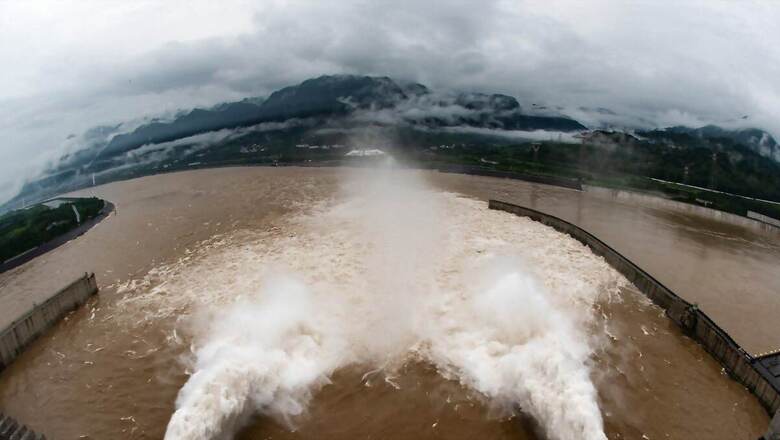
views
Since the annexation of Tibet in 1950, China has been exploiting Tibet’s rich natural resources, especially water, along with violating the human rights of the Tibetan population. Known as Asia’s Water Tower, Tibet is the world’s largest freshwater reserve outside the polar regions. Tibetan plateau and the Himalayas are also the primary sources of some of the major river basins in South and Southeast Asia such as the Ganges, Brahmaputra, Meghna, Indus and Mekong. Most of these rivers are transboundary in nature and flow through many South and Southeast Asian nations. This inevitably makes these low-riparian nations dependent on transboundary rivers.
To give a clearer picture, Bangladesh has over 57 transboundary rivers, while it shares 54 of them with India. These river basins, thus, are vital not only for meeting the economic needs, but also for the preservation of the ecosystem and biodiversity of the lower riparian nations.
With Tibet under Chinese control, water resources have emerged as China’s new weapon to achieve hydro-hegemony. Pertinently, China has undertaken substantial hydroelectricity projects as hydroelectricity is Tibet’s second largest energy source for China, after coal. China’s hydro-hegemonic ambitions, however, are coming in the way of lower riparian countries’ reliance on transboundary rivers flowing through these countries and their increasing demand for water in the face of rapid climate change. China’s hydro hegemonic ambitions are reflected in its big dam construction projects, aimed at water diversion and the use of artificial rain projects to regulate rainfall in barren areas of the Tibetan plateau.
China’s mega dam construction projects are rooted in its motive of meeting the country’s large energy demands, accounting for about 31 per cent of global hydropower as per 2022 data. The development of hydropower based on the Yarlung Tsangpo River finds mention as a ‘priority’ in China’s current 14th Five-Year Plan (2021-25). Because of its dominant position as an upper riparian nation and in order to cater to its increasing hydro-energy demands, the development of China’s infrastructure on upper riparian rivers has had a significant impact on water flow, adversely affecting the Mekong and Yarlung Tsangpo rivers.
Meeting energy demands, however, is not China’s only interest here. Beijing’s control of water flow and river diversion through the operationalisation of mega dams aims to have influence and exert dominance over its neighbouring lower riparian nations. In order to understand this game, it is important to see the flow of upper riparian rivers in China; the Yarlung Tsangpo and Mekong, are both known to be major transboundary rivers. Yarlung Tsangpo River, the world’s highest river, originates in the Manasarovar Lake in Tibet that eventually flows through the Indian states of Arunachal Pradesh (as Siang River) and Assam (as Brahmaputra) and bordering country Bangladesh before draining into the Bay of Bengal. The Mekong River, which also originates in the Tibetan plateau of the upper Mekong Basin, flows through six nations in Southeast Asia before flowing out to the South China Sea. This makes Mekong Southeast Asia’s largest river basin.
The announcement of China’s plan to build the world’s biggest hydropower dam (50-metre high with a capacity of 60 GW power production) on the lowest reaches of the Yarlung Tsangpo (Brahmaputra) river, in Medong country bordering India’s Arunachal Pradesh, is a case in point. Believed to be three times the size of China’s Three Gorges Dam, the world’s largest dam presently, the “Super Dam” on the Brahmaputra River is claimed to strengthen China’s water security and meet its clean energy goals. However, the location of this new mega-dam construction has raised suspicion for its neighbouring countries.
Accounting for 30 per cent of India’s freshwater resource, Brahmaputra River is significant not only for India, but is equally important for Bangladesh. Around 70 per cent of the Bangladeshi population reside in the Brahmaputra River basin. China’s opaque approach in its river diversion plan, through this new mega-dam construction, thus risks affecting both countries.
With India, China is already engaged in disputes along the borders and on infrastructure projects. The relationship, in this context, has witnessed further deterioration since 2020. Once constructed, the “Super Dam” is likely to trigger floods in India’s Northeast regions during monsoons and cause severe water shortages during the winter season. Moreover, the construction of dams on the Brahmaputra River would also lead to the consolidation of China’s baseless territorial claims over the Indian state of Arunachal Pradesh.
The satellite images revealed last year that China has been implementing a dam construction project since 2021 that is close to the Line of Actual Control (LAC). China had also withheld hydrological data during the Doklam Standoff in 2017, violating legally binding accords. This also added to New Delhi’s difficulties in managing annual floods affecting its Northeastern states. It is a reflection of how China has been weaponising water resources. Another similar case was witnessed in 2019 when China regulated the water flow of the Mekong River through its 11 large hydropower dams operational along the river basin. The Chinese actions had led to the worst drought witnessed in decades by lower Mekong countries; Myanmar, Laos, Cambodia, Thailand and Vietnam the following year. It had adversely affected millions of people in these countries whose source of livelihood and food were dependent on the Mekong River.
Last year, Bangladesh’s Daily Asian Age had reported that China’s approach toward water resources, reflected in its rampant dam construction projects, had adversely impacted environmental conditions, and caused large displacement of people and huge debt to low riparian countries in South and Southeast Asia.
China is not only exploiting its neighbours by leveraging its upper riparian status but also using it as an excuse to consolidate its claim over Tibet. The weather modification programme to induce artificial rain over barren plateau is one such example, causing disastrous effects on the climatic conditions of the Tibetan plateau. China’s major artificial rain experiment, the Sky High or Tianhe Project plan (2018), aims to boost extra rainfall over the plateau region through the process of fuel-burning chambers that will induce artificial rain. More than 500 of these fuel-burning chambers were reported to be installed across Tibetan mountains in 2018 itself.
The $19 million project witnessed further expansion in 2020, covering an area of over 5.5 million square kilometres (to be developed by 2025). In 2022, drones and rockets launched for the purpose of cloud seeding were seen over China’s Sichuan province. This was done to induce rainfall over more than 600 square kilometres of land witnessing extreme heatwaves and drought. Interestingly, now these areas have been witnessing their worst flood conditions for the past two years after the experiment.
The artificial alteration of weather through use of cloud seeding technology is controversial for many reasons, as it directly affects the ecosystem. The Tianhe Project, covering such an expansive area, not only endangers Tibet’s environment, but also China’s neighbouring countries, especially India. China, through its dam construction projects and weather modification programmes, seem to be weaponising water for its geostrategic interest.
China’s recent unilateral decision to donate 3,000 tonnes (1,500 tonnes donated in March and 1,500 tonnes in May) of potable glacial water from Tibet to Maldives, at the latter’s request, is the latest example of China’s exploitation of Tibet’s water resources for geopolitical gains. However, this act of Chinese benevolence had also raised concerns among the Tibetans in Tibet. Apparently, China’s water conservation regulations that set the limit on water usage in the Tibetan region were unveiled barely a week prior to the first consignment of water being dispatched to Maldives in March 2024.
Reportedly, Tibetans themselves are facing water shortage in Tibet due to decades of water management and conservation campaigns run by China for the exploitation of Tibetan water resources throughout the plateau. This, along with the dam construction projects, has paved the way for frequent displacement, including, the forced displacement of Tibetans from their ancestral land. Not to mention, Chinese water exploitation has been endangering the climate, flora and fauna of the Tibetan plateau as well.
Being a non-signatory of any transboundary water treaty, China seems to be exploiting Tibetan transboundary water sources as its own sovereign resources, demonstrated by its unilateral and belligerent actions. By leveraging its upper riparian status, China is using water as a weapon, raising environmental and livelihood concerns not only for its neighbouring countries, but also for the Tibetan plateau itself, the source of this “water weapon”.
The writer is an author and columnist and has written several books. His X handle is @ArunAnandLive. Views expressed in the above piece are personal and solely those of the author. They do not necessarily reflect News18’s views.


















Comments
0 comment